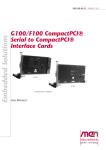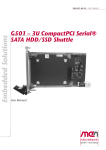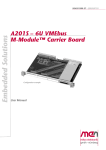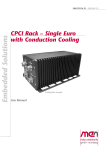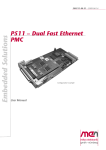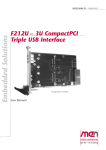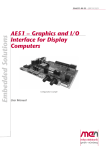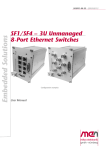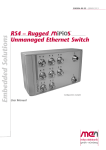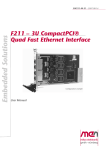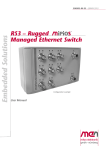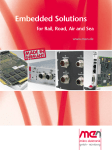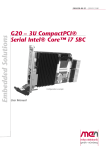Download 20F217-00 E1 User Manual
Transcript
Embedded Solutions
20F217-00 E1 – 2010-08-13
F217 – 3U CompactPCI®
Memory Card Carrier
Configuration example
User Manual
®
F217 - 3U CompactPCI® Memory Card Carrier
F217 - 3U CompactPCI® Memory Card Carrier
The F217 is a 3U 4HP CompactPCI® board which offers a multitude of memory
configurations. It is equipped with a CompactFlash® socket and a multi card reader
which supports MS, SD and MMC plus cards.
The memory cards are accessible at the front and can be inserted and removed
during operation (hot plug). They can optionally be protected by an EMC-proof
cover which also secures the cards mechanically, so that they cannot fall out. This
protection makes the boards especially suited for harsh environments. A button for
hot-extraction request and four status LEDs are also provided at the front panel.
The F217 is screened for operation in the extended temperature range of -40 to
+85°C.
MEN Mikro Elektronik GmbH
20F217-00 E1 – 2010-08-13
2
Technical Data
Technical Data
Memory
• One CompactFlash® card interface
- Type I/II
- UDMA Mode 0..4
- PIO Mode 0..6
- Via USB Flash media controller
• One multi card reader
- MS (Memory Stick 1.43)
- SD/SDHC (Secure Digital 2.0)
- MMC plus (Multi Media Card 4.2)
- Via USB Flash media controller
CompactPCI® Bus
• Compliance with CompactPCI® Core Specification PICMG 2.0 R3.0
• Peripheral slot
• V(I/O): +3.3 V
Electrical Specifications
• Isolation voltage:
- 1000 VAC between GND and SHIELD
• Supply voltage/power consumption:
- +3.3 V (-3%/+5%), 1.06 W (with CompactFlash and SD card)
Mechanical Specifications
• Dimensions: conforming to CompactPCI® specification for 3U boards
• Front panel: 4 HP with ejector
• Weight: 124 g (without cards)
Environmental Specifications
• Temperature range (operation):
- -40..+85°C (screened, depending on the cards used)
- Airflow: 1.0 m/s
• Temperature range (storage): -40..+85°C
• Relative humidity (operation): max. 95% non-condensing
• Relative humidity (storage): max. 95% non-condensing
• Altitude: -300 m to + 3,000 m
• Shock: 15 g, 11 ms
• Bump: 10 g, 16 ms
• Vibration (sinusoidal): 1 g, 10..150 Hz
• Conformal coating on request
MTBF
• 1,190,023h @ 40°C according to IEC/TR 62380 (RDF 2000)
MEN Mikro Elektronik GmbH
20F217-00 E1 – 2010-08-13
3
Technical Data
Safety
• PCB manufactured with a flammability rating of 94V-0 by UL recognized manufacturers
EMC
• Conforming to EN 55022 (radio disturbance), IEC1000-4-2 (ESD) and
IEC1000-4-4 (burst)
Software Support
• Windows®
• Linux
• For more information on supported operating system versions and drivers see
online data sheet.
MEN Mikro Elektronik GmbH
20F217-00 E1 – 2010-08-13
4
Block Diagram
4 User-Definable
LEDs
I2C Port Expander
SMBus
USB Flash Media
Controller
PCI-to-USB Host
Controller
User-Definable
Push-Button
CompactFlash
Socket
CompactPCI J1 Connector
Block Diagram
Multi Card
Reader
MEN Mikro Elektronik GmbH
20F217-00 E1 – 2010-08-13
5
Configuration Options
Configuration Options
Mechanics
• Front panel cover for EMC and mechanical protection
Please note that some of these options may only be available for large volumes.
Please ask our sales staff for more information.
For available standard configurations see online data sheet.
MEN Mikro Elektronik GmbH
20F217-00 E1 – 2010-08-13
6
Product Safety
Product Safety
!
Electrostatic Discharge (ESD)
Computer boards and components contain electrostatic sensitive devices.
Electrostatic discharge (ESD) can damage components. To protect the board and
other components against damage from static electricity, you should follow some
precautions whenever you work on your computer.
• Power down and unplug your computer system when working on the inside.
• Hold components by the edges and try not to touch the IC chips, leads, or circuitry.
• Use a grounded wrist strap before handling computer components.
• Place components on a grounded antistatic pad or on the bag that came with the
component whenever the components are separated from the system.
• Store the board only in its original ESD-protected packaging. Retain the original
packaging in case you need to return the board to MEN for repair.
MEN Mikro Elektronik GmbH
20F217-00 E1 – 2010-08-13
7
About this Document
About this Document
This user manual describes the hardware functions of the board, connection of
peripheral devices and integration into a system. It also provides additional
information for special applications and configurations of the board.
The manual does not include detailed information on individual components (data
sheets etc.). A list of literature is given in the appendix.
History
Issue
E1
Comments
First issue
Date
2010-08-13
Conventions
!
italics
bold
monospace
hyperlink
This sign marks important notes or warnings concerning proper functionality of the
product described in this document. You should read them in any case.
Folder, file and function names are printed in italics.
Bold type is used for emphasis.
A monospaced font type is used for hexadecimal numbers, listings, C function
descriptions or wherever appropriate. Hexadecimal numbers are preceded by "0x".
Hyperlinks are printed in blue color.
The globe will show you where hyperlinks lead directly to the Internet, so you can
look for the latest information online.
IRQ#
/IRQ
Signal names followed by "#" or preceded by a slash ("/") indicate that this signal is
either active low or that it becomes active at a falling edge.
in/out
Signal directions in signal mnemonics tables generally refer to the corresponding
board or component, "in" meaning "to the board or component", "out" meaning
"coming from it".
MEN Mikro Elektronik GmbH
20F217-00 E1 – 2010-08-13
8
About this Document
Legal Information
MEN Mikro Elektronik reserves the right to make changes without further notice to any products herein. MEN makes no
warranty, representation or guarantee regarding the suitability of its products for any particular purpose, nor does MEN assume
any liability arising out of the application or use of any product or circuit, and specifically disclaims any and all liability,
including without limitation consequential or incidental damages.
"Typical" parameters can and do vary in different applications. All operating parameters, including "Typicals" must be
validated for each customer application by customer's technical experts.
MEN does not convey any license under its patent rights nor the rights of others.
Unless agreed otherwise, MEN products are not designed, intended, or authorized for use as components in systems intended
for surgical implant into the body, or other applications intended to support or sustain life, or for any other application in which
the failure of the MEN product could create a situation where personal injury or death may occur. Should Buyer purchase or
use MEN products for any such unintended or unauthorized application, Buyer shall indemnify and hold MEN and its officers,
employees, subsidiaries, affiliates, and distributors harmless against all claims, costs, damages, and expenses, and reasonable
attorney fees arising out of, directly or indirectly, any claim of personal injury or death associated with such unintended or
unauthorized use, even if such claim alleges that MEN was negligent regarding the design or manufacture of the part.
Unless agreed otherwise, the products of MEN Mikro Elektronik are not suited for use in nuclear reactors or for application in
medical appliances used for therapeutical purposes. Application of MEN products in such plants is only possible after the user
has precisely specified the operation environment and after MEN Mikro Elektronik has consequently adapted and released the
product.
ESM™, ESMini™, MDIS™, MDIS4™, MDIS5™, MENMON™, M-Module™, M-Modules™, SA-Adapter™, SAAdapters™, UBox™, USM™ and the MBIOS logo are trademarks of MEN Mikro Elektronik GmbH. PC-MIP® is a
registered trademark of MEN Micro, Inc. and SBS Technologies, Inc. MEN Mikro Elektronik®, ESMexpress®, MIPIOS®
and the MEN logo are registered trademarks of MEN Mikro Elektronik GmbH.
microSD™ is a trademark of SD-3C, LLC. Microsoft® and Windows® are registered trademarks of Microsoft Corp.
Windows® Vista™ is a trademark of Microsoft Corp. PCI Express® and PCIe® are registered trademarks of PCI-SIG.
CompactFlash® is a registered trademark of SanDisk Corp.
All other products or services mentioned in this publication are identified by the trademarks, service marks, or product names
as designated by the companies who market those products. The trademarks and registered trademarks are held by the
companies producing them. Inquiries concerning such trademarks should be made directly to those companies. All other brand
or product names are trademarks or registered trademarks of their respective holders.
Information in this document has been carefully checked and is believed to be accurate as of the date of publication; however,
no responsibility is assumed for inaccuracies. MEN Mikro Elektronik accepts no liability for consequential or incidental
damages arising from the use of its products and reserves the right to make changes on the products herein without notice to
improve reliability, function or design. MEN Mikro Elektronik does not assume any liability arising out of the application or
use of the products described in this document.
Copyright © 2010 MEN Mikro Elektronik GmbH. All rights reserved.
Please recycle
Germany
MEN Mikro Elektronik GmbH
Neuwieder Straße 5-7
90411 Nuremberg
Phone +49-911-99 33 5-0
Fax +49-911-99 33 5-901
E-mail [email protected]
www.men.de
MEN Mikro Elektronik GmbH
20F217-00 E1 – 2010-08-13
France
MEN Mikro Elektronik SA
18, rue René Cassin
ZA de la Châtelaine
74240 Gaillard
Phone +33 (0) 450-955-312
Fax +33 (0) 450-955-211
E-mail [email protected]
www.men-france.fr
USA
MEN Micro, Inc.
24 North Main Street
Ambler, PA 19002
Phone (215) 542-9575
Fax (215) 542-9577
E-mail [email protected]
www.menmicro.com
9
Contents
Contents
1 Getting Started . . . . . . . . . . . . . . . . . . . . . . . . . . . . . . . . . . . . . . . . . . . . . . . .
1.1 Map of the Board. . . . . . . . . . . . . . . . . . . . . . . . . . . . . . . . . . . . . . . . .
1.2 Integrating the Board into a System . . . . . . . . . . . . . . . . . . . . . . . . . .
1.3 Installing Driver Software . . . . . . . . . . . . . . . . . . . . . . . . . . . . . . . . . .
13
13
15
15
2 Functional Description . . . . . . . . . . . . . . . . . . . . . . . . . . . . . . . . . . . . . . . . . .
2.1 Power Supply. . . . . . . . . . . . . . . . . . . . . . . . . . . . . . . . . . . . . . . . . . . .
2.2 Flash Media Controller . . . . . . . . . . . . . . . . . . . . . . . . . . . . . . . . . . . .
2.3 CompactFlash Socket . . . . . . . . . . . . . . . . . . . . . . . . . . . . . . . . . . . . .
2.4 Multicard Reader . . . . . . . . . . . . . . . . . . . . . . . . . . . . . . . . . . . . . . . . .
2.5 LEDs and Request Button . . . . . . . . . . . . . . . . . . . . . . . . . . . . . . . . . .
2.5.1
LED Control . . . . . . . . . . . . . . . . . . . . . . . . . . . . . . . . . . . . .
2.5.2
Button Control. . . . . . . . . . . . . . . . . . . . . . . . . . . . . . . . . . . .
2.6 CompactPCI Interface . . . . . . . . . . . . . . . . . . . . . . . . . . . . . . . . . . . . .
2.7 Front Panel Cover (Optional) . . . . . . . . . . . . . . . . . . . . . . . . . . . . . . .
16
16
16
16
16
17
17
17
18
18
3 Appendix . . . . . . . . . . . . . . . . . . . . . . . . . . . . . . . . . . . . . . . . . . . . . . . . . . . . .
3.1 Literature and Web Resources . . . . . . . . . . . . . . . . . . . . . . . . . . . . . . .
3.1.1
CompactFlash . . . . . . . . . . . . . . . . . . . . . . . . . . . . . . . . . . . .
3.2 Finding out the Product’s Article Number, Revision and
Serial Number . . . . . . . . . . . . . . . . . . . . . . . . . . . . . . . . . . . . . . . . . . .
19
19
19
MEN Mikro Elektronik GmbH
20F217-00 E1 – 2010-08-13
19
10
Figures
Figure 1. Map of the board – front panel . . . . . . . . . . . . . . . . . . . . . . . . . . . . . . . 13
Figure 2. Map of the board – top view. . . . . . . . . . . . . . . . . . . . . . . . . . . . . . . . . 14
Figure 3. Labels giving the product’s article number, revision and
serial number . . . . . . . . . . . . . . . . . . . . . . . . . . . . . . . . . . . . . . . . . . . . 19
MEN Mikro Elektronik GmbH
20F217-00 E1 – 2010-08-13
11
Tables
Table 1.
Table 2.
Table 3.
Table 4.
MEN Mikro Elektronik GmbH
20F217-00 E1 – 2010-08-13
Supported card formats. . . . . . . . . . . . . . . . . . . . . . . . . . . . . . . . . . . . .
SMBus addresses of port expander . . . . . . . . . . . . . . . . . . . . . . . . . . .
LED control . . . . . . . . . . . . . . . . . . . . . . . . . . . . . . . . . . . . . . . . . . . . .
Button control . . . . . . . . . . . . . . . . . . . . . . . . . . . . . . . . . . . . . . . . . . . .
16
17
17
17
12
Getting Started
1
Getting Started
This chapter gives an overview of the board and some hints for first installation in a
system.
1.1
Map of the Board
Figure 1. Map of the board – front panel
®
1
2
3
4
F217
MEN Mikro Elektronik GmbH
20F217-00 E1 – 2010-08-13
13
Getting Started
Figure 2. Map of the board – top view
met.
CompactFlash
Socket
8
C
4
0
Hex
Switch
Multicard Reader
MEN Mikro Elektronik GmbH
20F217-00 E1 – 2010-08-13
14
Getting Started
1.2
Integrating the Board into a System
You can use the following check list when installing the board in a system for the
first time and with minimum configuration.
; Power-down the system.
; Insert the F217 into a peripheral slot of your CompactPCI system, making sure
that the CompactPCI connectors are properly aligned.
Note: The peripheral slots of every CompactPCI system are marked by a circle
on the backplane and/or at the front panel.
; Insert a CompactFlash and/or MS/SD/MMC card.
; Power-up the system.
; You can now install driver software.
1.3
Installing Driver Software
For a detailed description on how to install driver software please refer to the
respective documentation.
You can find any driver software available for download on MEN’s website.
MEN Mikro Elektronik GmbH
20F217-00 E1 – 2010-08-13
15
Functional Description
2
Functional Description
2.1
Power Supply
Power supply is fed via the CompactPCI backplane. The board operates on +3.3 V.
2.2
Flash Media Controller
The F217 offers the possibility to connect a CompactFlash as well as an SD, MMC
or MS Flash device. They are controlled by a Flash Media Controller which is
connected to the PCI bus via a PCI to USB host controller.
2.3
CompactFlash Socket
The F217 offers a CompactFlash socket for CompactFlash media type I and II
which supports UDMA Mode 0..4 and PIO Mode 0..6. The cards can be inserted
from the front panel.
2.4
Multicard Reader
The F217 provides a multi card socket for SD, MMC and MS media accessible on
the front panel. The following types of flash media device can be used on the F217:
Table 1. Supported card formats
Type
SD/SDHC
Standard
Secure Digital 2.0 [SD]
miniSD/
micro SD
with SD adapter
MS
Memory Stick 1.43
MS Pro
Memory Stick Pro Format 1.02
MS Duo
Memory Stick Duo 1.10
with MS adapter
MS Pro-HG Duo
Memory Stick Pro-HG Duo 1.01
with MS adapter
MMC plus
Multi Media Card 4.2
1/4/8 bit MMC
RS-MMC/
MMC-micro
MEN Mikro Elektronik GmbH
20F217-00 E1 – 2010-08-13
Comment
with MMC adapter
16
Functional Description
2.5
LEDs and Request Button
The F217 provides four user-definable LEDs and a request button at the front panel
which can be controlled via an I2C expander connected to the SMBus. MEN
provides a driver for accessing the SMBus. See MEN’s website for more
information and downloads.
Eight different SMBus addresses can be set for the I2C expander using a hex switch
to avoid conflicts with other SMBus devices in the system. See Table 2, SMBus
addresses of port expander on page 17.
For the position of the hex switch see Figure 2, Map of the board – top view on page
14.
Table 2. SMBus addresses of port expander
Switch Position
4
8
0
C
2.5.1
SMBus Address
0
40
1
42
2
44
3
46
4
48
5
4A
6
4C
7
4E
8..F
Mirror
LED Control
The four LEDs are controlled by the first four GPIOs of the port expander.
• Logic High on related SMBus data results in an inactive LED
• Logic Low on related SMBus data results in an active LED.
Per default the four LEDs are inactive after power up.
Table 3. LED control
LED Number
1
2
3
4
2.5.2
GPIO of SMBus
LED 1
I/O0
LED 2
I/O1
LED 3
I/O2
LED 4
I/O3
Button Control
The request button at the front panel is controlled by I/O4 of the port expander.
Table 4. Button control
GPIO of SMBus
Button
MEN Mikro Elektronik GmbH
20F217-00 E1 – 2010-08-13
I/O4
17
Functional Description
2.6
CompactPCI Interface
The F217 supports a 32-bit 33-MHz CompactPCI interface fully compatible with
CompactPCI specification PICMG 2.0 Rev. 3.0. The board works with 3.3V and
tolerates 5V V I/O.
For full CompactPCI functionality only the J1 connector is needed, therefore the
board only has a J1 connector to the bus.
Connector type of J1:
• 110-pin shielded, 2mm-pitch, 5-row receptacle according to IEC 917 and IEC
1076-4-101
The pin assignment of connector J1 as defined in the CompactPCI specification will
not be repeated here.
2.7
Front Panel Cover (Optional)
As an option the F217 can be equipped with a front panel cover which ensures EMC
protection and also mechanical fixation for the cards to ensure that they do not fall
out. A special board version is required for this. Please contact MEN’s sales team
for further information.
MEN Mikro Elektronik GmbH
20F217-00 E1 – 2010-08-13
18
Appendix
3
Appendix
3.1
Literature and Web Resources
• F217 data sheet with up-to-date information and documentation:
www.men.de/products/02F217-00.html
3.1.1
CompactFlash
• CompactFlash Association:
www.compactflash.org
3.2
Finding out the Product’s Article Number, Revision and
Serial Number
MEN user documentation may describe several different models and/or design
revisions of the F217. You can find information on the article number, the design
revision and the serial number on two labels attached to the board.
• Article number: Gives the product’s family and model. This is also MEN’s
ordering number. To be complete it must have 9 characters.
• Revision number: Gives the design revision of the product.
• Serial number: Unique identification assigned during production.
If you need support, you should communicate these numbers to MEN.
Figure 3. Labels giving the product’s article number, revision and serial number
Complete article number
02F217-00
00.00.00
Revision number
Serial number
MEN Mikro Elektronik GmbH
20F217-00 E1 – 2010-08-13
19



















